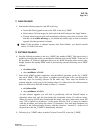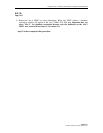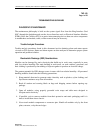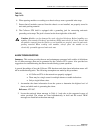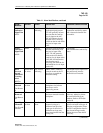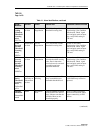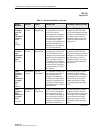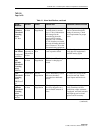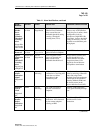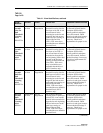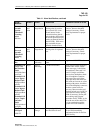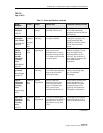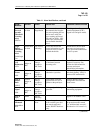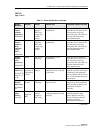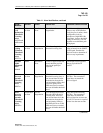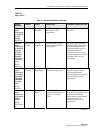
1152700• Issue 1 • February 2001 • Section 2 Operations and Maintenance
Page 2-426
© 2000, ADC Telecommunications, Inc.
TAP-100
Page 7 of 23
Table 4-1. Alarm Identifications, continued
ALARM
MESSAGE
SEVERITY IMPACT DESCRIPTION SUGGESTED COURSE OF ACTION
Discard
Header
Error
Count
Violation
Threshold
Crossing
Alert
DiscardHec
VioThresho
ldExceeded
Information
al Alert
Service
Degradation
Cells discarded due to
Header Error Checksum
have crossed the user
definable threshold setting
causing a Threshold
crossing alert (TCA).
Could be caused by a port
failure at any ATM interface.
Verify the port is online, check
configuration, look for
indications of high BER (Bit
Error Rate), increase threshold
settings if necessary, use line
loopback to troubleshoot path
through port.
EIM
Removed
Information
al Alert
Service
Degradation
EIM has physically been
pulled from the backplane.
Install EIM card as needed.
Egress
Congestion
High
Threshold
Crossing
Alert
EgressCong
estHighTca
Information
al Alert
Service
Degradation
Cells congested on the
egress of reported port
have crossed a user
definable threshold level.
Review traffic contracts and
modify threshold level if
needed. Monitor for future
congestion alarms. Cells
tagged for discard become
susceptible to termination.
Endpoint
Alarm
Indication
Signal
EndpointAI
S
Minor Service
Affecting
Endpoint of reported
connection is receiving AIS
code due to a failure
somewhere in the
connection path.
Check connection originating
point by retrieving connection
status and using OAM
loopback from test equipment.
Check input at the Electrical
Interface Module (EIM) and
the facility status on the
Access Interface Card (AIC).
Endpoint
Loss of
Clock
EndpointL
OC
Minor Service
Affecting
No ATM cell traffic is
present at connection
endpoint.
Perform ATM loopback to
verify path continuity through
port.
Endpoint
Remote
Defect
Indication
EndpointR
DI
Minor Service
Affecting
Endpoint remote defect
indication. AIS is detected
by the remote endpoint
causing an RDI.
Check the AIC and EIM that
feed the traffic for the
connection.
(continued)



